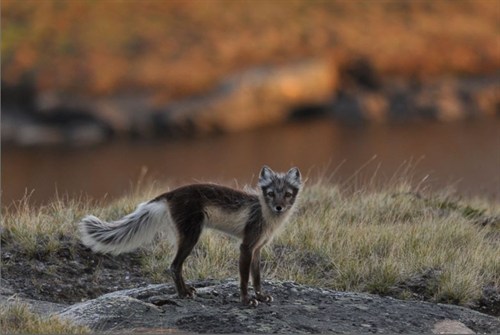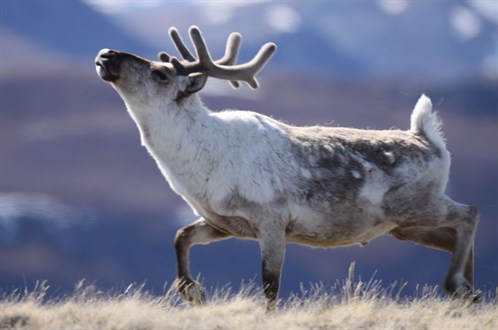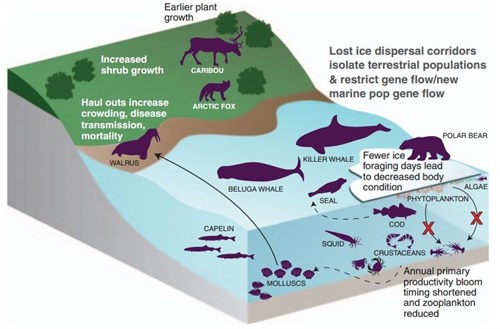Many of the impacts of retreating Arctic sea ice are reasonably well known. But the loss of sea ice isn’t just a climate issue, it’s also an ecological one. A new review article in the journal Science examines the effect of climate change in the Arctic on the plants, animals and ecosystems of the region.
Temperatures in the Arctic have risen twice as fast as the global average in recent decades. Sea ice cover is in long term decline. In the summer of 2012, sea ice reached its lowest level since satellite records began in 1979.
Scientists agree that the decline will have consequences for the climate – extra heating and possible changes to weather patterns. But, as the new review article explores, the loss of sea ice and warming oceans will have an impact on the Arctic’s wildlife too.
Working up the food chain
The Science article examines a range of scientific literature to explain how changes in the region affect life at all scales.
At the lowest levels of the food chain, some of the simplest underwater creatures like algae and phytoplankton are feeling the effects of sea ice loss. Algae and phytoplankton have a short and dramatic life cycle. They have one growth spurt each season, when the sea ice thins and retreats exposing them to the sunlight they need to make energy.
With sea ice melting earlier each year, algae and phytoplankton populations are peaking earlier, and starting to decline sooner. This can mean that by the time predators looking to feed on them arrive, much of the food source is gone.
The fallout from this mismatch in timing spreads through the food chain, affecting bigger animals. Crustaceans and fish like the Arctic cod struggle to find enough food. Mammals which feed on cod, like seals, go hungry. Polar bears feed on seals, and can struggle to lay down enough fat to survive long winters.
Sea ice loss also alters the physical landscape of the region, limiting the movement of Arctic animals. Some species use the sea ice to hunt and sleep, while land-based animals like the Arctic fox and wolves use it as a bridge to reach other places, allowing them to breed with other populations and maintain a healthy gene pool. Without it, these populations will become isolated and could decline, the paper concludes.

Being increasingly bound to the land as sea ice retreats has other risks, including the easy spread of disease and crossbreeding. For polar bears, more time on land increases the likelihood of crossbreeding with grizzly bears.
A leaner, greener Arctic
It’s not just animals affected by changes in the region. More heat will be absorbed by the open ocean as sea ice retreats – known as the albedo effect – leading to further warming in the region.
That extra heat will affect surrounding icy land masses too, the article explains. Much of the land in the Arctic circle is frozen, with a layer on top which thaws during the warmer months of the year.
This semi-frozen land, or permafrost , is expected to thaw more extensively and for a longer period of time as Arctic sea ice shrinks, temperatures rise and the summer season lengthens. This could release methane – a powerful greenhouse gas.
Another consequence of longer thaw seasons is that plants are likely to start growing earlier in the year. In parts of Greenland, frozen areas are already greening up early, with the growth spurt of simple plant species peaking before migrating Caribou arrive to feed. This is causing a timing mismatch similar to that taking place in the ocean food chain.

Taking the land areas in the Arctic as a whole, plant growth does seem to have increased as sea ice has declined, the authors say.
The upside of this is that more carbon may be being stored in plant life, rather than the atmosphere. But with the potential for extra methane to be released from thawing permafrost it’s hard to say whether a greener Arctic is speeding up or slowing down climate change.
Under pressure
Directly or indirectly, the loss of Arctic sea ice poses the risk of serious impacts on wildlife in the region. In some cases it’s already happening. Changes at the bottom of the food chain are likely to be felt at the top, and a warming ocean will likely thaw its neighbouring land.
As the Science review article points out, sea ice loss isn’t just a warning sign of climate change – it’s something which actively drives ecological change. With climate change adding to a host of other pressures on the region, from fishing to shipping and mineral exploration, the Arctic’s wildlife is facing a difficult future.
Post et al. (2013) Ecological Consequences of Sea-Ice Decline. Science. DOI: 10.1126/science.1235225
Note: All images in this blog are property of lead author Eric Post and co-author Jeffrey Kirby, University of Pennsylvania.


